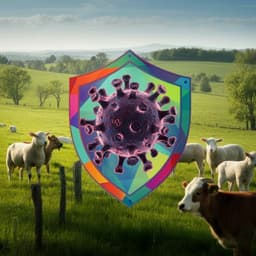
Veterinary Science
Safety and efficacy assessment of an mRNA rabies vaccine in dogs, rodents, and cynomolgus macaques
J. Li, P. Yu, et al.
Explore groundbreaking research by Jianglong Li and colleagues on the mRNA rabies vaccine LVRNA001, which demonstrated complete protection against rabies in dogs and safeguarded mice from various strains. With promising safety profiles, this vaccine could revolutionize rabies prevention.
~3 min • Beginner • English
Introduction
Rabies is a widespread, fatal zoonotic disease caused by rabies virus (RABV), leading to ~60,000 deaths annually, with a high burden in Africa and Asia and substantial mortality in children. The viral glycoprotein (G), the only surface-exposed protein, is the principal target of neutralizing antibodies and cellular responses and is thus the key antigen for vaccine development. Existing veterinary rabies vaccines (inactivated, live attenuated, and recombinant subunit/viral vector) have limitations, including multiple dosing for inactivated vaccines, potential reversion risks for live attenuated vaccines, and limited protection with some recombinant vectors. mRNA vaccines offer rapid, scalable manufacturing, flexible antigen design, and do not integrate into the host genome. Prior mRNA rabies vaccines expressing RABV-G have shown promising immunogenicity and protection in animals and early clinical studies; however, safety and immunogenicity in a more clinically relevant non-human primate model had not been comprehensively evaluated. The present study aims to confirm efficacy of the mRNA vaccine candidate LVRNA001 in dogs and mice (pre- and post-exposure) across multiple RABV clades, and to systematically assess its safety, immunogenicity, and potential reproductive toxicity in cynomolgus macaques and rats, respectively, addressing a key gap toward clinical translation.
Literature Review
The paper reviews prior rabies vaccine modalities and mRNA vaccine advances: inactivated, live attenuated, and recombinant vector vaccines have documented drawbacks such as multi-dose requirements, risk of reversion to virulence, and limited protection. mRNA vaccine platforms have demonstrated rapid development and strong immunogenicity in preclinical and clinical settings. Non-replicating mRNA vaccines expressing RABV-G (e.g., RV021, unmodified or nucleoside-modified mRNA-LNP formulations) induced protective virus-neutralizing titers in animals and phase 1 trials. A single dose of nucleoside-modified RABV-G mRNA vaccines has conferred effective protection and potent humoral responses in animals. Despite these advances, no commercial rabies mRNA vaccine is available, and comprehensive evaluation in non-human primates has been limited. WHO and CDC guidelines for pre- and post-exposure prophylaxis are summarized to contextualize dosing schedules compared in this study.
Methodology
Vaccine: LVRNA001 is a non-replicating mRNA encoding the RABV glycoprotein (G) from the CTN-1 strain (GenBank ACR39382.1), produced by in vitro transcription and encapsulated in lipid nanoparticles (LNPs). Inactivated rabies vaccine (human use, Liaoning Chengda, lot 4150466A, 1 dose ≥2.5 IU) served as comparator.
Cells/viruses: BHK-21 and BSR cells cultured in DMEM with 10% FBS. RABV CVS-11 and street virus BD06 were propagated in BHK-21. Cross-clade challenge strains SC16, GD1, NM3, QH2, LY, YN3, XZ17 represent China I–VII.
Ethics: All animal procedures followed institutional IACUC approvals and ARRIVE guidelines.
Dogs (pre-exposure): Beagles (4–6 months) randomized (n=6/group). Vaccination: LVRNA001 10 or 50 µg i.m. on D0 and D7; inactivated vaccine human dose on D0, D7, D21; PBS control. Challenge: 50× LD50 BD06 i.m. on D35. Serum collected D7, D9, D11, D35, D125 for neutralization (FAVN). Survival monitored to D125.
Dogs (post-exposure): Beagles infected i.m. with 50× LD50 BD06. Six hours later, vaccinated with LVRNA001 10 or 50 µg i.m. on D0 and D7; inactivated vaccine on D0, D3, D7, D14, D28; PBS control. Neutralization at D90; survival to 3 months.
Mice immunodynamics: BALB/c females (n=6/group) received LVRNA001 5 µg i.m. as single (D0), D0–7, or D0–14 schedules; inactivated vaccine 1/10 human dose D0,3,7,14,28. Sera D3–D42 assessed by RFFIT.
Mice pre-exposure efficacy: BALB/c females (n=10/group) received LVRNA001 1.67 µg or 5 µg (single or D0–7) or inactivated vaccine (1/10 or 1/30 human dose, D0–7). Challenge on D14 with 50× LD50 of strains SC16, GD1, NM3, QH2, LY, YN3, XZ17 i.m. Survival to D42.
Mice post-exposure efficacy: BALB/c females challenged i.m. with 50× LD50 SC16, GD1, NM3, QH2, LY, YN3, XZ17; 2 h later vaccinated with LVRNA001 1.67 or 5 µg on D0–7 or D0–14; inactivated vaccine 1/10 or 1/30 human dose D0,3,7,14,28. Survival evaluated 28 days post-immunization; monitored to 35 days.
Acute toxicity in CD-1 mice: 30 mice (equal sex) randomized to saline, LVRNA001 10 µg, or 50 µg i.m. single dose (D0); clinical signs and body weight measured over 14 days.
Cynomolgus macaques (toxicity/immunogenicity): 40 animals (2.8–4.4 years; equal sex) randomized (n=10/group) to saline, Empty LNP, LVRNA001 50 µg, or 150 µg, i.m. on D0, D7, D21, D35 (0.5 mL). Clinical monitoring; body weight and temperature tracked. Blood at pre-specified time points for biochemistry (FIB, AST, ALT, ALP, A/G, CRP), FAVN titers, and lymphocyte subsets (CD3+, CD3+CD4+, CD3+CD8+, CD3−CD20+ by flow cytometry). ELISpot for IFN-γ on D39 after stimulation with overlapping RABV-G peptides. Histopathology of 54 tissues including injection site on D39 (n=6/group) and D64 (n=4/group).
Reproductive toxicity in Sprague-Dawley rats: 336 rats randomized into saline, Empty LNP, LVRNA001 25 µg, LVRNA001 50 µg groups (28 males, 56 females per group). Males dosed D0, D7, D21, D35; mating initiated D42. Females (two cohorts): EFD phase dosed D14 (−28 days to pairing), D21, D35, GD6; cesarean on GD20. Littering phase females dosed D14, D21, D35, GD6, and PND7; natural delivery; offspring monitored to PND21. Outcomes: pregnancy number, uterine/placental weight, live/dead fetuses, birth index, lactation index. Neutralization assays: RFFIT in mice; FAVN in dogs and macaques. Statistics: one-way or two-way ANOVA with Tukey’s test; p<0.05 significant.
Key Findings
Dogs: Pre-exposure, two doses of LVRNA001 (10 or 50 µg, D0–7) or inactivated vaccine (D0–7–21) yielded 100% survival after 50× LD50 BD06 challenge on D35; PBS group 0% survival. All vaccinated dogs had neutralizing antibodies above 0.5 IU/mL at D7, D9, D11, D35, D125; LVRNA001 groups maintained higher titers than inactivated vaccine at D125 (p<0.05). Post-exposure, after infection with 50× LD50 BD06 and vaccination starting 6 h later, two doses of LVRNA001 (10 or 50 µg, D0–7) or five doses of inactivated vaccine achieved 100% survival through 90 days; PBS group had 0% survival. At 3 months, LVRNA001 groups showed higher neutralizing titers than inactivated vaccine (p<0.05).
Mice immunodynamics: LVRNA001 5 µg induced higher and faster neutralizing responses with boosting. D0–14 > D0–7 > single-dose. By D42, two-dose LVRNA001 titers significantly exceeded those of the inactivated vaccine administered five times. A single LVRNA001 dose produced higher titers by Day 5 than two doses of inactivated vaccine; LVRNA001 titers crossed 0.5 IU/mL earlier.
Mice efficacy across clades: Pre-exposure vaccination (LVRNA001 or inactivated) resulted in 100% survival against 50× LD50 challenges from China I–VII strains; unvaccinated virus-only groups averaged 10% survival (7/70). Post-exposure, LVRNA001 5 µg achieved 85.71% (D0–7) and 88.57% (D0–14) survival; 1.67 µg achieved 42.86% (D0–7) and 60.00% (D0–14). Inactivated vaccine (five doses) yielded 52.86% (1/10 dose) and 32.86% (1/30 dose) survival. The D0–14 interval outperformed D0–7.
Acute toxicity in CD-1 mice: Single-dose LVRNA001 (10 or 50 µg) showed no significant adverse clinical signs or effects on body weight or weight gain vs saline over 14 days.
Cynomolgus macaques safety: Repeated dosing (50 or 150 µg on D0, 7, 21, 35) was well tolerated. Body weight and temperature remained stable. Liver enzymes (AST, ALT, ALP) unchanged. Transient increases in fibrinogen (FIB) and C-reactive protein (CRP) and a decrease in albumin/globulin ratio (A/G) occurred in LNP-containing groups near dosing, resolving by D64. Lymphocyte subset frequencies (CD3+, CD4+, CD8+, CD20+) remained stable. Histopathology showed only mild, transient injection-site inflammation at D39 that resolved by D64; other organs showed no pathological lesions.
Cynomolgus immunogenicity: LVRNA001 elicited strong neutralizing antibody titers (>20,000 IU/mL on D35), remaining high at D64; ELISpot detected significantly increased IFN-γ–secreting T cells in mRNA-immunized animals vs controls, indicating a Th1-biased response.
Reproductive toxicity in rats: No significant differences among groups in pregnancy rates, uterine/placental weights, number of live fetuses, or dead fetus rate (0% across groups) in the EFD phase. In the littering phase, birth and lactation indices were comparable (near 100%) across groups, and pup survival from PND4 to PND21 was similar. Male fertility was unaffected.
Discussion
The study demonstrates that the mRNA rabies vaccine LVRNA001 confers robust protection against lethal RABV challenge in both dogs and mice under pre- and post-exposure settings. In mice, LVRNA001 provided cross-clade protection against representative China I–VII strains, with superior post-exposure survival compared to a multi-dose inactivated vaccine, and benefited from a longer (D0–14) boost interval. In dogs, two LVRNA001 doses sufficed for complete protection in both prophylactic and post-exposure scenarios, with sustained neutralizing antibody titers. The safety profile across species was favorable: acute toxicity was absent in mice; in cynomolgus macaques repeated dosing caused only transient, LNP-associated inflammatory marker changes (FIB, CRP, A/G) that resolved during convalescence, with no systemic toxicity, stable lymphocyte subsets, and only mild transient injection-site inflammation. Importantly, macaques mounted very high neutralizing titers and a Th1-skewed cellular response, supporting the vaccine’s potential to control RABV. Reproductive toxicity studies in rats showed no adverse effects on fertility, gestation, parturition, or neonatal outcomes. Collectively, these findings address the need for a safe, effective rabies vaccine platform with streamlined schedules, and extend prior rodent and canine data by adding comprehensive non-human primate safety and immunogenicity evidence, supporting advancement toward clinical evaluation.
Conclusion
LVRNA001, an mRNA vaccine encoding RABV-G, provided complete protection in dogs and strong cross-clade protection in mice under pre- and post-exposure conditions, generating rapid and durable neutralizing antibodies. Repeated-dose toxicity studies in cynomolgus macaques revealed no systemic toxicities and only transient, LNP-related inflammatory changes, while immunogenicity analyses showed robust neutralizing titers and Th1-biased T cell responses. Reproductive toxicity testing in rats indicated no adverse effects on fertility, pregnancy, or offspring outcomes. These preclinical efficacy and safety data support LVRNA001 as a promising candidate for rabies prophylaxis and therapy. Future work should include clinical trials in humans to confirm safety, optimal dosing schedules for pre- and post-exposure use, durability of immunity, and broader cellular immune profiling.
Limitations
Human clinical data are not yet available, and no viral challenge was performed in non-human primates. The macaque observation period was limited to 9 weeks (with histopathology at D39 and D64), and dog follow-up to 125 days, leaving longer-term safety and durability unassessed. Post-exposure efficacy comparisons in mice used specific doses and schedules; broader dose-ranging and mechanistic studies (e.g., breadth of T cell responses beyond IFN-γ) were not detailed. Transient increases in inflammatory biomarkers (FIB, CRP) and decreased A/G ratio in macaques indicate LNP-associated reactogenicity that resolved post-recovery but warrants continued monitoring.
Related Publications
Explore these studies to deepen your understanding of the subject.







